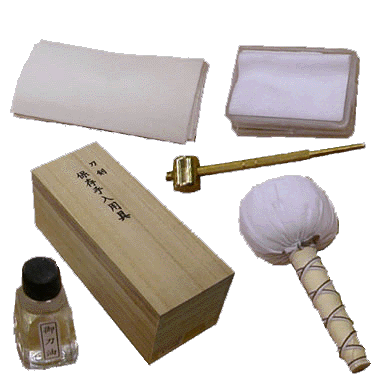KATANA BLADE MAINTENANCE
The Katana, like any finely crafted blade, requires meticulous care to maintain its integrity and performance. Due to the high-carbon steel used in traditional Katanas, the blade is susceptible to oxidation and rust if not properly maintained. Regular cleaning and oiling are essential to preserve the sharpness and aesthetic appeal of the blade.
Traditional Maintenance Techniques
In the Samurai tradition, maintaining a Katana begins with disassembly. The sword is carefully separated from the Koshirae (handle and fittings), exposing the blade for thorough cleaning. One of the first steps involves applying a special powder made from polishing stones. This powder is gently tapped onto the blade using a soft pad, releasing fine particles that help absorb moisture and debris.
Next, the blade is wiped clean with rice paper, tightly wrapped around both sides of the blade and drawn from the base to the tip. This process removes any residual dust and dirt. Once the blade is spotless, it is coated with Choji oil, a traditional clove-scented oil that acts as a protective barrier against rust and oxidation. Applying the oil involves soaking a fresh piece of rice paper and gently rubbing it along the entire length of the blade.
The Importance of Regular Maintenance
In ancient Japan, where the climate was often humid, especially in summer and winter, rust could easily form on neglected blades. Proper maintenance routines became vital for Samurai who needed their swords to remain battle-ready. Today, traditional methods are still respected for their effectiveness and cultural significance.
However, modern alternatives are also gaining popularity. Reputable swordsmiths, such as Yarinohanzo, recommend using Ballistol, a synthetic oil originally designed for firearms. This oil forms a durable protective layer over the steel, significantly reducing the risk of rust and requiring less frequent reapplication—typically every six months. This modern solution is particularly suitable for practitioners and collectors who want reliable long-term protection.
Post-Use Care
Whenever the Katana is used, whether for practice or demonstration, it is crucial to reapply oil afterward. Any contact with moisture, sweat, or other materials increases the risk of oxidation. The process is simple: take a clean cloth, apply a small amount of oil, and wipe the blade from handle to tip. This not only protects the steel but also restores its glossy finish.
Identifying and Treating Rust
Despite diligent maintenance, rust may occasionally appear, especially if the blade is exposed to unfavorable conditions. There are two types of rust to watch for:
-
Active Rust (Red Rust) - This type is the most harmful, as it rapidly spreads and can permanently damage the blade. It appears as reddish spots and should be addressed immediately.
-
Stable Rust (Black Rust) - Less aggressive and typically forms as dark stains. While not as destructive, it can still affect the blade’s appearance and value.
The process of removing rust involves professional polishing, which not only eliminates corrosion but also restores the edge and finish of the blade. Attempting to polish the blade without proper knowledge can cause further damage, especially to the Hamon (temper line).



